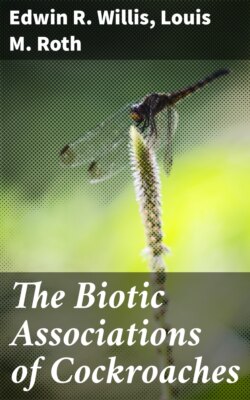Читать книгу The Biotic Associations of Cockroaches - Edwin R. Willis - Страница 12
На сайте Литреса книга снята с продажи.
III. ECOLOGICAL RELATIONSHIPS
ОглавлениеTable of Contents
The ecology of extinct cockroaches is necessarily a highly speculative subject. From the coexistence of fossil cockroaches and fossil plants in the same geological stratum, one might conclude that there had been intimate associations between them during prehistoric life. Heer (1864) and Goldenberg (1877) suggested that Carboniferous cockroaches fed on the plants with which they have been found as fossils. Scudder (1879) concurred with this hypothesis. However, Bolton (1911), remarking on the noticeable associations of blattoid wings with vegetable remains, suggested that the cockroaches may have been partly carnivorous, feeding on the snails Spirorbis pusillus, which were attached to the leaves of Cordaites. Yet the proximity of fossil insects and plants in the same geological formation is hardly proof of a similar association during life. In fact, Sellards (1903), Bolton (1921), and Laurentiaux (1951) have all pointed out that the cockroach remains, particularly the more resistant wings, may have been washed into streams by heavy rains and transported with drifting plant material to places where permanent deposits were accumulating.
Some species of fossil cockroaches have long, well-developed ovipositors, very unlike present-day cockroaches whose ovipositors are small and nonprotruding. Brongniart (1889) and Zalesskii (1939, 1953) have suggested that certain Permian and Carboniferous cockroaches with long ovipositors may have inserted their eggs singly into trees and other plants, rather than protecting the eggs with an oötheca. However, Laurentiaux (1951), although conceding the possibility of egg laying in vegetable material, suggested that oviposition into the earth is more probable because of the unbending nature of the ovipositor.
Although the ecological associations of modern cockroaches should be well known from direct observation, actually most species are still little more than names on museum specimens, and our knowledge of them is fragmentary. All too frequently ecological observations have been only incidental to taxonomic or faunistic studies; yet the biological information that is contained in such papers is all that we know of many species. For this reason we have cited these observations in some detail, especially when they were brief; longer accounts of cockroach bionomics, of necessity, have been abstracted.
Very few exclusively ecological studies of insects have included cockroaches. The native woodroaches (Parcoblatta pensylvanica, P. uhleriana, and P. virginica) of the northern United States were included in ecological studies of the Orthoptera by Hubbell (1922), Strohecker (1937), and Cantrall (1943). Fifteen species of cockroaches were included in an ecological study of the Orthoptera of northern Florida by Friauf (1953). The original papers should be consulted for detailed descriptions of the habitats and accounts of the associated plants and other Orthoptera.
In this chapter the cockroaches are grouped into those that have been found in man-made structures and those that occur in other habitats. Certain species may appear in several categories because they live both indoors and out. The structural pests are divided into cockroaches that occur in land-based structures, those on ships, and those in aircraft. The nonstructural cockroaches are divided into those that occur in quite specific habitats (caves, water, and deserts) and those that occur generally out of doors. Nests of various arthropods serve as microhabitats of commensal cockroaches; these latter associations are discussed on pages 310-318.
In this chapter our discussion is limited to the physical environment and specific habitats of cockroaches, and only very general references are made to associated organisms. The relationships of cockroaches to the biota are examined in detail in subsequent chapters. To show the full extent of the associations, the associates, from bacteroids to vertebrates, are arranged phyletically. These associate-centered classifications serve admirably to relate various species of cockroaches within common bounds, but fail to give an integrated account of the total biotic relationships in the ecology of each species. Although physically separated in this monograph, the many associates of each species of cockroach should all be considered in appraising the ecology of that species. To assist the reader to achieve this end, we have included a checklist (p. 290) which serves as a convenient index to certain organisms associated with particular species of cockroaches.
